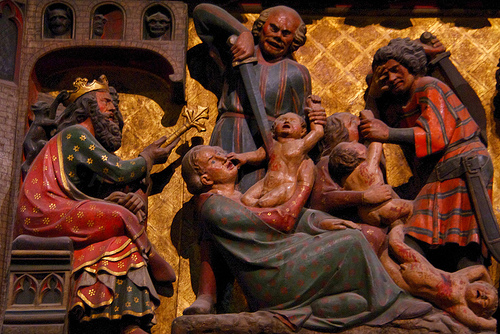We run our website the way we wished the whole internet worked: we provide high quality original content with no ads. We are funded solely by your direct support. Please consider supporting this project.

Is the Bible History?
Even though I argued for interpreting the final form of the biblical canon as opposed to using the history behind the text in my post yesterday, I am not endorsing the radical post-modern view that biblical texts possess “semantic autonomy” and thus lack any historical referentiality. While I have no problem whatsoever accepting that God used folklore and myth in his “God-breathed” word, and while I grant that the line between “history” and “fiction” in ancient writers was not nearly as hard and fast as it is for modern historians, I am nevertheless persuaded that, unless we have reasons to think otherwise, we should accept that history-looking narratives were written with a historical intent.
Yet, to affirm the historical-intentionality of history-looking narratives is not to affirm that the “God-breathed” status or authority of such narratives depends on our determining their congruity with someone’s reconstruction of “what actually happened.” In Barth’s terms, history-looking narratives may be geschichte (narrated history) even if they do not qualify as historisch (demonstrable history), for “Nicht alle Geschichte ist historisch.” (“Not all history is historical.”) So too, I affirm, with Barth, that it is as geschichte, not historisch, that biblical narratives can to be considered “God-breathed.”
For this same reason, unless I have exegetical reasons for thinking a passage belongs to the genre of folklore or myth, I adopt a “biblical realist” stance and treat history-looking narratives as historical (geschichte), without concerning myself with the extent to which they may or may not conform to someone’s historical-critical reconstruction of “what actually happened.”
So too, while I argue on Christological, theological, and literary grounds that the way OT authors sometimes theologically interpret events reflects a culturally-conditioned perspective that followers of Jesus must regard as pen-ultimate, I nevertheless treat as historical the events they theologically interpret.
Hence, for example, while I argue that followers of Jesus must reinterpret Jeremiah’s portrait of Yahweh smashing the heads of children and parents in the Babylonian siege of Jerusalem (Jer. 13), I do not question that this siege actually took place and that it in fact involved children and parents being smashed together in the process. Similarly, while I argue that we must, in the light of Christ, reinterpret the Genesis author’s view that Yahweh sent the flood that wiped out almost every living human and animal on the earth, I treat the narrative as historical without concerning myself with the contested issues of how this narrative coheres with the geological record and thus with whether the flood was global, local or even mythic.
Along the same lines, my view of interpreting the final form of the canon does not lead me to concern myself with critical discussions regarding the alleged pre-canonical history of any passage. It’s not to deny the findings of source and redactional criticism. Rather, my silence is due to my conviction that these arguments are irrelevant to my theological commitment to work with the final canonical form of the biblical text.
To give one illustration, many critical scholars view the Conquest narrative as a compilation of a number of originally independent traditions. Among these traditions, it is argued, we may discern one that depicted Yahweh promising to get the children of Israel into the promised land by slowly relocating the Canaanites, another that depicts Yahweh promising to relocate the Canaanites through the use of pestilence, and yet another in which Yahweh is portrayed as telling Moses to have the Israelites slaughter “everything that breathes.” The arguments supporting this perspective lead me to consider it to be quite probable. Yet, because these traditions ended up being woven together as a single canonical narrative, I consider this (potentially historically complex) narrative to be “God-breathed” and thus shall treat it as a single narrative. And, despite the fact that many critical scholars are convinced it reflects little “actual history,” I shall nevertheless treat it as historical, for its authority as a witness to geschichte is not contingent upon its congruity with the scholarly opinion of historisch.
In this light of this, we should assume that, even if history-looking canonical narratives do not reflect the historical facts as we would assess them in modern historical analysis, they nevertheless pass on a memory of what God has done in the world and include a real truth that often can’t be captured by our modern conceptions about how history should be recorded.
Image by Vasnic64 via Flickr.
Category: General
Tags: Bible, Bible Interpretation, Cruciform Theology, Historical Criticism
Topics: Biblical Interpretation
Related Reading

A Cruciform Dialectic
One of the most important aspects of God’s action on Calvary, I believe, is this: God revealed himself not just by acting toward humans, but by allowing himself to be acted on by humans as well as the fallen Powers. God certainly took the initiative in devising the plan of salvation that included the Son…

From Boston, With Love
We posted some of T. C. Moore’s reflections on the Open 2013 conference earlier this week. T. C. lives in Boston and was deeply moved by the violence and terror that came to his city. Now we want to share his most recent blog post Oz and the Cross: Reflections on God’s Love and the…

Jesus Refuted Old Testament Laws
Although it’s clear that Jesus regarded the Old Testament as the inspired word of God, he also directly challenged aspects of the Old Testament law. To illustrate, Jesus was repudiating Sabbath law when he defended his disciples’ harvesting of food on the Sabbath (Mt 12:1-14; cf. Ex. 34:21). Some scholars argue that the disciples were…

Getting Behind the “Letter” of Violent Portraits of God
“I will do to you what I have never done before… in your midst parents will eat their children, and children will eat their parents…” Ezek. 5:9-10 In my previous post I offered a brief review of Matthew Bates’ fascinating work, The Hermeneutics of the Apostolic Proclamation by Matthew Bates (Baylor University Press, 2012). Among other…

The Cross and the Witness of Violent Portraits of God
In my previous post I noted that the prevalent contemporary evangelical assumption that the only legitimate meaning of a passage of Scripture is the one the author intended is a rather recent, and very secular, innovation in Church history. It was birthed in the post-Enlightenment era (17th -18th centuries) when secular minded scholars began to…

On Biblical Interpretation
chad via Compfight Today we’re linking to a blog post from Rachel Held Evans about Biblical interpretation. In her post, Rachel writes about the complexities Christians encounter when our scriptural interpretations differ (emphasis is Rachel’s): What is perhaps most frustrating about engaging in such conversations within the evangelical community in particular, however, is that differences…
